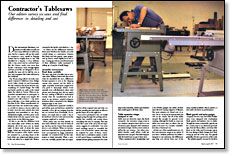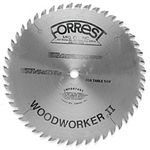Contractor’s Tablesaws
Our editors survey six saws and find differences in detailing and cost
Synopsis: This tool test of 10-in. contractors saws takes a close look at the Bridgewood #TSC-10C, Delta #36-440, Grizzly #G1022Z, Jet #JWTS-10JF, Powermatic #64 Artisan, and Ryobi #BT 300. Charts list specs for all the tools, and the text talks about how to evaluate various features, such as the clarity of the assembly instructions, the table extension wings (stamped or cast?), blade guards and miter gauges, rip fences, and price.
Delta International Machinery Corporation would rather not tell you how many tablesaws it sells every year, but the company will say this much: Its contractor’s saws outsell its flagship Unisaw line by roughly three to one. That shouldn’t be a surprise. A 10-in. tablesaw with a 3-hp motor and an enclosed base, like the Unisaw, easily costs more than $1,500. Contractor’s saws, though lighter and less powerful, are designed to do essentially the same job for half the cost or less, and companies like Delta sell them by the truckload.
Fine Woodworking editors recently compared contractor’s tablesaws from Bridgewood, Delta, Grizzly, Jet and Powermatic. We also looked at the Ryobi BT3000 saw, something of a hybrid design. The Delta and Ryobi models are made in the United States, the others in Taiwan. When we approached manufacturers to participate in this review, the criteria were simple: We wanted a saw with at least a -hp motor that would take a 10-in. blade and that cost less than $1,000. When manufacturers offered more than one model in this category, we left it to them to choose which one to send. Once the saws arrived, they were unpacked and assembled in our shop, checked thoroughly, and then put to work. Details about each saw appear in the summary boxes on the following pages.
It’s fair to say that the tablesaws look very much alike; some of them are nearly identical. All of the saws rest on stands made of sheet steel of about the same gauge. Tables are of about the same size. With the exception of the Ryobi, motors are mounted on a pivoting frame at the back of the saw cabinet and deliver power to the saw arbor by a single belt. Motors (except for the Ryobi) were listed at 1½hp.
So where are the differences between these saws? Mostly in the details, not in the overall design or construction. Features like blade and belt guards, miter gauges and rip fences varied slightly from saw to saw. Coming up with an overall assessment of these tablesaws really amounted to adding up a long list of small things.
From Fine Woodworking #123
For the full article, download the PDF below:
Fine Woodworking Recommended Products

Rockler Dust Right 650 CFM

Forrest Woodworker II Blade

Ridgid EB4424 Oscillating Spindle/Belt Sander




















Log in or create an account to post a comment.
Sign up Log in